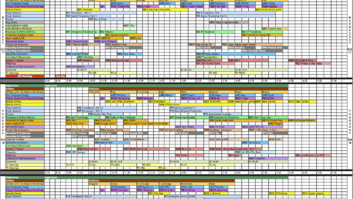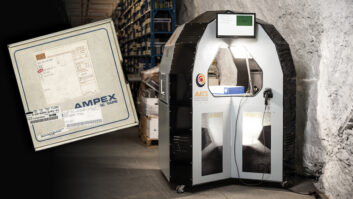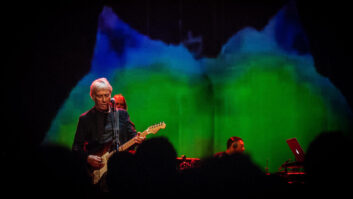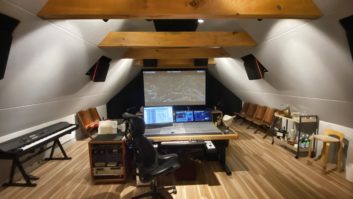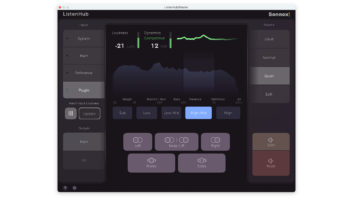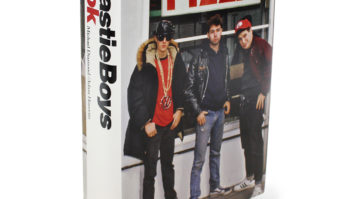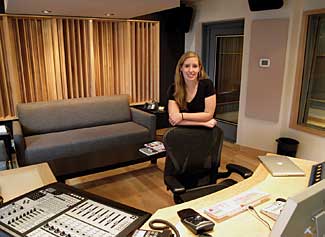
Hillary Martell in audioEngine’s Studio E
Is New York City still a place to believe in? Whatever your specialty, the Big Apple remains a very solid draw for the ambitious. But that drive is easy when the big picture is all about hope and potential — how about when the hard realities set in?
Those realities revealed themselves to the New York City-based recording industry long before the globe started feeling the pinch of our current economic crisis. To review, the seeds for the world-money meltdown were sown in July 2007 when securitized mortgages began looking extra shaky to investors, prompting an injection of capital into financial markets that would eventually spike credit risk to extremely volatile levels.
As the house of cards was being built downtown on Wall Street that year, the last New York City AES show was taking place uptown on the West Side. Things have changed on both fronts: Like investment houses and the city’s tax base, the local recording industry has taken some big hits in the past two years. The difference is that the people who lead New York City’s facilities — flagship to personal studio — actually saw the crunch coming and braced themselves.
The result is that while some notable recording rooms have closed since the last AES — including Legacy Recording’s Studio A509, Philip Glass’ Looking Glass Studios, upstate’s Allaire Studios and LoHo Studios in the Lower East Side — a great many others have hung in there, doing what’s essential to remain in business. And new facilities and rooms continue to open.
How Are the Flagships?
At West 48th Street, the nonstop buzz of Times Square is just 50 yards from the front door of Legacy Recording Studios. A recent landmark change in the neighborhood’s zoning has closed several blocks of the area to traffic, converting this Crossroads of the World into a surprisingly pleasant (if somewhat surreal) pedestrian mall.
Inside Legacy, the fluctuating traffic flow in and out of its studios — and everyone else’s — has been a topic of consistent interest since the New York City AES show two years ago.
“What’s different in New York City since AES 2007 is that there are fewer recording studios,” says Chris Bubacz, Legacy general manager. “What hasn’t changed is that there are studios that have been able to hang in there and survive these storms that have come up. So you still have our studio, Legacy, as well as Avatar, Electric Lady, Chung King, Quad, Dubway and the smaller studios downtown; we’ve all figured out a way to keep it going.
“The record business, in the last two years, is about the same,” Bubacz continues. “When the record labels are ready to work, we’re busy. When they’re not, we have to fill our time with more independently funded projects like Broadway shows, film scores and the like.”
At Quad Recording Studios, which now looks out from its tenth-story perch at Times Square, adapting means shaping the studio — literally — around client needs. The facility has cut the live room of its SSL J 9064-equipped Studio A in half to make room for a new studio (currently in development) and lounge within that space. Meanwhile, a smaller Larry Swist-designed production room, Studio F, has also recently come online.
“One thing is obvious: Everyone is feeling the economic crunch,” explains Rick Hosn, president of Quad. “It’s getting tougher and tougher to get decent rates. The label budgets are shrinking, and our ‘COD’ clients are looking for better deals. As a studio, we have to make sure we can accommodate everyone without sacrificing the quality of our service. Our clients don’t want to spend the big bucks on the big rooms anymore. One way to deal with that challenge is to build the smaller rooms and offer the better deals. We were one of the first people to open a small-format Digidesign ICON room, and it’s been a great success.”
Uptown, the relative quiet of West 53rd Street makes Avatar Studios feel more like a country getaway — Hell’s Kitchen-style. For that facility, the convenience of a comprehensive services offering is key.

Alex Moulton, Expansion Team creative director, conceived of a “studio without a studio.”
“There is a lot of downward pressure on overall recording budgets,” acknowledges Kirk Imamura, president of Avatar Studios. “With the different kind of rooms and resources we have in our recording complex, including mastering, we offer a complete set of options for multiple stages of production to match clients’ budgetary requirements. We might do basic tracks in the big room, do overdubs in smaller ones, edit in the Pro Tools suite, and then mix and master with quick iterative revisions. By keeping a project under one roof, the flow is not interrupted, the quality is maintained and projects are completed quickly and efficiently.”
New York City is undeniably blessed with many of the world’s best live tracking rooms, still an essential ingredient for orchestral recordings, Broadway cast albums, symphonic sessions and bands that like to record while playing together in the same place at the same time. Rooms at other larger-scale studios such as Clinton Recording Studios, KAS Music, Manhattan Center Studios and Sear Sound will always have jobs to bid on, albeit with tighter budgets in tow.
“The primary advantage for us is the size and number of our tracking rooms,” Imamura states, referring to such spaces as Avatar’s 2,496-square-foot Studio A and 980-square-foot Studio C. “There are fewer and fewer large rooms available for large ensembles, orchestral dates and cast albums in the city. These are sessions that you simply cannot do at home or in small project studios.”
A Sharper Focus
Both Dave Amlen (Sound on Sound, Legacy Recording Studios) and Troy Germano (Hit Factory) used to be at the helm of huge New York City facilities. Today, however, the two can be found running a much different type of studio than their multi-room complexes of before.
Each now runs a two-room studio — significantly more tightly focused operations closely overseen by these seasoned studio executives. The eponymous Germano Studios, opened in 2008, is in the stylish NoHo neighborhood, featuring a pair of 48-input SSL Duality rooms. Amlen founded Manhattan Sound Recording and opened in June of this year, converting the already-pleasant compound previously occupied by the Manhattan Producer’s Alliance into two extremely well-equipped Digidesign C24 recording and production suites.
“The world has changed and the ‘boutique’ recording facility is what is most desired,” says Germano, owner and president of Germano Studios. “The bands and artists want the highest level of privacy, and that is impossible in a four- or five-room studio. Fortunately, there are not many multi-room studios left, so leaner is the answer. My plan has only been to open numerous smaller studios in different cities — locations that artists would be attracted to, not necessarily locations that musicians have now become bored of. When the [Germano Studios] space in NoHo accidentally came to me, the size and intimacy put my ideas in motion.”
Amlen notes that running the relatively compact MSR feels much different than his previous studios. “With a large facility, there are more opportunities to charge for services,” he says. “Conversely, there are more monthly obligations in staff and infrastructure costs. I think my new studio is a strong statement about the direction and needs of my clientele. The new direction is more personal attention. I think once you grow past two or three rooms, you lose the personal connection. Ultimately, many two- and three-room facilities are the goal, whereby each facility will have its own unique personality. The financial beauty will be in the sharing of back office and technical resources. We [Manhattan Sound Recording] are not there yet, but I hope we will be sooner than later.”
The final key to running these sonic sports cars is keeping two steps ahead of everybody else — or is it? “As for keeping ahead of the curve,” says Amlen, “I think you always need to be aware of the curve, but never on the leading edge because the financial pitfalls are hard to recover from, unless you can force the work during the learning stages while the equipment stabilizes. Most of us are not that fortunate.”

Germano Studios’ Studio 1 features an SSL Duality, and reflects owner Troy Germano’s business plan of opening smaller “boutique” studios.
We Live in Brooklyn
Brooklyn Heights, Williamsburg, Bushwick, Canarsie, Bedford-Stuyvesant, Park Slope, Clinton Hill, Cobble Hill, Boerum Hill, Carroll Gardens, Prospect Heights, Greenpoint, Coney Island, King’s Highway, Dyker Heights, Bensonhurst, Mill Basin, Flatbush. Get the point? There’s a lot of room for music to maneuver in the borough whose Dutch name means “Broken Land.” With many professional and semi-pro musicians and audio pros — for more than a generation now — in flight from Manhattan’s high prices and cramped lodgings, critical mass has been reached and then some in Brooklyn.
Jamin Gilbert opened ishlab, a studio/licensing/music supervision concern in the artsy/industrial neighborhood of DUMBO (Down Under Manhattan Bridge Overpass) in 2000. “There has been a continuous and growing influx of musicians and artists toward New York City, and to Brooklyn in particular,” Gilbert observes. “New York has always been one of the greatest music Meccas of the world, and Brooklyn has risen as one of the strongest creative communities. The eclectic space and architectural elements provide a recording scene that inspires collective creativity and healthy competition, both necessary components of a growing artistic and musical environment. Being in the heart of this community for a decade has definitely allowed us to observe the ebb and flow of the music — we’re lucky to have been in Brooklyn long enough to fully understand the dynamic of the environment here.
“It’s important that the industry find other ways to make money other than as a traditional recording facility,” Gilbert continues. “By helping to carve out niche music communities that do things differently, we can all work together to promote the local recording industry. We are embarking on a couple of great opportunities right now, capitalizing on the emerging trends of audio sensory branding for commercial activities. Our background in recording, mixing and DJ’ing allows us to understand the local market, as well as trends around the globe, and turn this into opportunities for our artists and commercial clients.”
Virtually Existent
Keeping that big globe firmly in mind, and the need to be everywhere at once — beyond the comfy confines of the five boroughs — is another formative factor for New York City music professionals. His company’s headquarters are on a SoHo cobblestone street, but Alex Moulton, creative director/partner of busy commercial music house Expansion Team, refers to his M.O. as a “studio without a studio.”
Instead of carrying the overhead of a dedicated recording facility, Moulton and his clients are happy with the results from a decentralized global composer network, capable of working efficiently together on projects. “We have a business model that puts creativity first, and I truly believe that musicians create better music when they work in comfortable surroundings, with players and engineers they love,” says Moulton. “These days, that means recording at your personal studio and not having to come into the office. Since we work with composers all over the world, we get the benefit of all of those rooms and session players.
“When you add it up, it just doesn’t make sense to have a central studio facility in New York City,” Moulton continues. “Instead, we have a simple but beautiful mix room that’s great for clients, but doesn’t require all of the gear necessary for recording. The fact that this business model has kept our overhead down is secondary to me, but it has definitely helped; it’s allowed us to grow organically and we’re able to pay our composers well. The only challenge we face is in the misconception that not having a studio means that the music-making process is more complicated or slower. In fact, we all share a central server and we’re able to keep working around the clock because of the different time zones of our artists.”
“Going into 2008, most people were expecting growth, and by the end of the year it was obvious that we’d taken an entirely different direction, to put it mildly,” says Moulton. “Rates and fees are down and competition is much higher, and there’s no telling when things will level out. But it’s not just the music industry — it’s true for nearly everyone I know. It’s a different landscape now, with smaller financial returns but increased opportunities for creativity. And New York City is still at the center of those creative opportunities.”
David Weiss is Mix’s New York editor.

Quad Studios’ president Ricky Hosn (left) and operations manager Vince Orsini
Two New Post Players
Everyone wants to be “the post with the most.” Even though advertising budgets are in tatters, a plethora of elite options remain in the extremely competitive New York City audio post scene. In fact, fresh mix-to-picture capacity has recently been added to the Manhattan skyline in the forms of two new mix suites at audioEngine (www.audioengine.net), and an entirely new facility called Sonic Union (www.sonicunion.com).
Residing just a tad south of the downtown border at 12th Street and Broadway, audioEngine ordered up its two new suites in 2007, when business was booming and the elite facility was routinely turning down work. Although conditions feel much more threatening today, audioEngine’s co-founders — Rex Recker, Brian Wick, Tom Goldblatt and Bob Giammarco — have set their company up for maximum competitiveness with their advanced pair of Walters-Storyk Design Group rooms.
“We knew that we needed another Dolby-approved room for theatrical work,” Giammarco says. “We wanted to build high-end rooms that were acoustically correct, and work with a designer like John Storyk, who did the original rooms at audioEngine when it was known as Lower East Side.”
Returning to the site of his original 1998 eighth-floor design, Storyk now found himself designing a build-out on audioEngine’s seventh floor. For mixer Hillary Kew Martell, the result was “The French Quarter” — aka the minimalist, chic 29×17 Studio E, a 5.1 room with exceedingly clean lines, Digidesign D-Command control, Sony HD projector and 122-inch diagonal Stewart screen, and a Dolby certification for theatrical sound mixes.
“Nothing has changed, and on the other hand everything has changed,” Storyk says of the differences between audio post design today and a decade ago, when he first helped shape the facility. “The standards have gotten tougher, and so the environments improve. It used to be that the equipment brokered everything. It was ridiculously expensive and hard to get, but now it’s been democratized.
“So what distinguishes one studio from the other?” continues Storyk. “The environments and the people. We’re constantly being called on to step up the environments, which could mean daylight in the room, improved acoustics and 5.1 is finally getting some legs.”
Just across the hall, but seemingly a world away, is an equal and opposite suite created for recently added star mixer Rob DiFondi. “The Cabin,” or Studio F, has the feel of a spacious (27×20) and rustic luxury log-cabin complete with fireplace holding a 65-inch Sharp LC flat-screen. DiFondi commands commercial campaign mixes via a Digidesign Pro Tools HD3 workstation, while monitoring via B&W 5.1 speakers with 803D mains, SCMS surrounds and an ASW855 sub.
As welcoming as they are acoustically accurate, audioEngine’s two new rooms bring them up to six suites total, backing up their belief that the high end can continue to expand. “I think there will always be room for quality,” notes Giammarco. “We’re inevitably going to see some players fall away because New York City right now is over capacity. If I had a crystal ball to see the future of this business, I’d be very popular in our company — and with some of our competitors! For our part, we have to continue to be financially smart, keep up relations with our clients and keep working to be the best at what we do.”
Meanwhile, a brash counterpoint has set up shop just a few blocks uptown on the West side of Union Square in the guise of Sonic Union. Founded by in-demand mixers Michael Marinelli (formerly of Buzz/NY) and Steve Rosen (formerly of HSR/NY), along with managing director Adam Barone, Sonic Union sports five total rooms. The pleasantly advanced environment takes maximum advantage of a glorious park view, while allowing Rosen and Marinelli to tackle their favorite mixing activity.
“I think that the biggest change in New York City since AES 2007, with regards to the commercial audio post industry, is that surround mixing has gone from being attempted to being expected,” says Marinelli. “Well over half of the spots we mix at Sonic Union are being finished in HD and mixed in surround. I have to say that after mixing as long as Steve Rosen and I have, it’s been a welcome addition to our daily routine.”
Sonic Union’s inviting layout feels alive with natural colors, textures and abundant light. “When we set out to design our new home,” Marinelli recalls, “one of our main objectives was to not build a place that looked like it was designed by a bunch of audio geeks. Through some crazy circles we met this brilliant architect, Raya Ani, who had never designed anything like this — she worked on huge projects like the New York Stock Exchange, The Time Warner Towers at Columbus Circle and the first Green School in New York City. Sonic Union was the first project undertaken by her own architectural practice. Because we were planning on using Rich Alderson for the acoustics and technical design, we felt we could push the envelope on facility design and that Richard would make sure that the rooms would sound incredible.”
For the main suites, Alderson created two approximately 600-square-foot rooms, each running Pro Tools HD3 systems and bolstered by Blue Sky Big Blue and Genelec monitoring systems. Endowed with a 120-inch projection screen, Rosen’s room qualified for and received a Dolby approval.
“Sonic Union’s clients have grown up in the dotcom world and are totally accustomed to working in a minimal environment with a small equipment footprint,” Alderson says of the open-feeling rooms. “A lot of care went into accommodating the display screens and projector so that they could have very good visual contact. In a typical post session, there can be as many as 10 people in the room, so care was taken with the monitoring to ensure everyone could hear well, no matter where they were sitting.”
The design philosophy backs up Sonic Union’s 10,000-foot view on what it takes to succeed in New York City’s hotly contested audio post scene. “More and more it’s not about the tools as much as it’s about the talent and the relationships,” concludes Marinelli. “We just want to continue to put out the kind of mixes that make our clients look and sound great.”
— David Weiss
